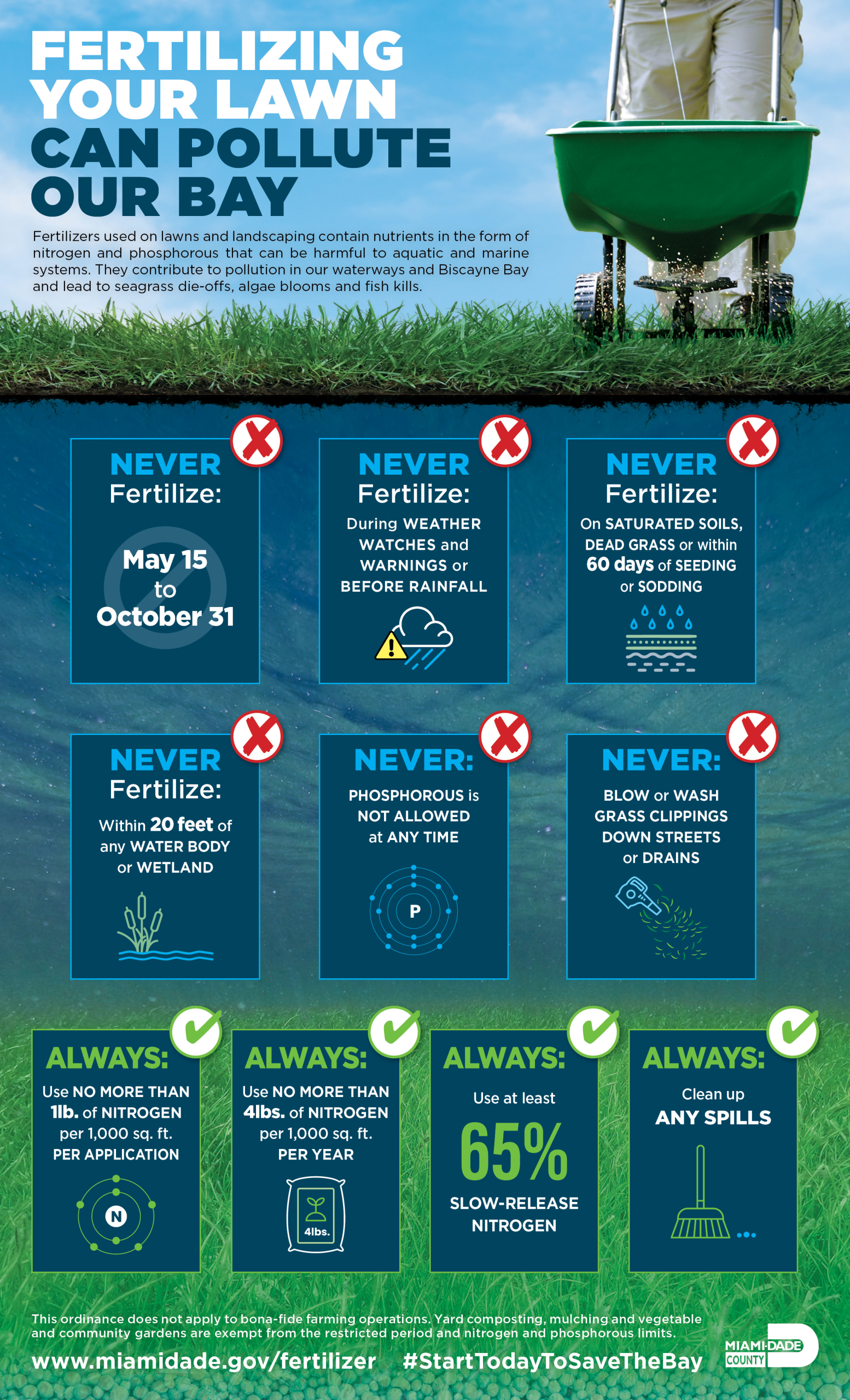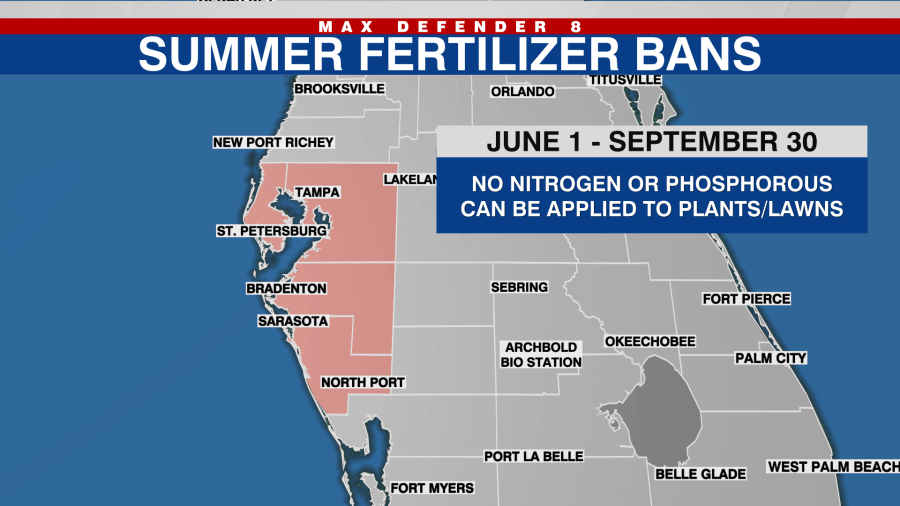
Chinch Bugs vs. Sod Webworms: Spotting the Difference in Your Florida Lawn
Whether you’re a new homeowner in Florida or a long-time resident, you already know that conditions in the Sunshine State…

In this comprehensive guide, we’ll break down everything you need to know about the fertilizer ban and how to keep your lawn thriving during restricted periods.
The Florida fertilizer ban typically runs from June 1 to September 30, coinciding with the state’s rainy season. However, specific regulations can vary significantly by county and municipality. The ban specifically targets two key fertilizer components: nitrogen (N) and phosphorus (P). When examining fertilizer bags, you’ll notice three numbers (N-P-K) that indicate the proportion of these nutrients. During the ban period, you cannot use products where the first two numbers (representing nitrogen and phosphorus) are greater than zero. However, potassium (K) and other micronutrients remain permitted.
Several categories are typically exempt from the fertilizer ban, though specific exemptions vary by county. These often include agricultural production, sod farms, golf courses, and athletic fields. It’s crucial to verify your local regulations, as exemptions can differ significantly between jurisdictions. For example, some counties may allow golf courses to use limited amounts of nitrogen and phosphorus during the ban, while others prohibit it entirely.
To check the exact restrictions in your area, you can consult the University of Florida’s IFAS Extension website, which maintains an up-to-date map of fertilizer ordinances across the state. This resource provides a county-by-county breakdown of ban dates, exemptions, and specific rules. By familiarizing yourself with local regulations, you can ensure compliance and avoid potential fines or penalties.
Florida’s unique climate and geography make it particularly vulnerable to fertilizer-related environmental issues. During the rainy season, which coincides with the fertilizer ban, Florida experiences substantial precipitation. This excess water can carry fertilizer components, particularly nitrogen and phosphorus, into storm drains and waterways via surface runoff.
Once in the water, these nutrients can trigger harmful algae blooms that have far-reaching effects on the ecosystem. Algae blooms can deplete the water of oxygen, creating “dead zones” that are inhospitable to fish and other aquatic wildlife. Some types of algae, such as red tide, can also produce toxins that harm marine life and even cause respiratory issues in humans.
In addition to the ecological impact, algae blooms can have significant economic consequences. They can lead to beach closures, fishing restrictions, and reduced tourism, all of which can hurt local businesses and communities.
While environmental protection is the primary driver behind these regulations, it’s worth noting that a 2024 University of Florida study indicated that more research is needed to definitively prove the ban’s effectiveness in preventing pollution. The study found that while fertilizer bans can reduce nutrient concentrations in runoff, other factors such as septic tank leakage and agricultural activities also contribute to the problem.
Despite this, many communities maintain these precautionary measures as part of a larger strategy to protect Florida’s delicate ecosystem. By reducing the amount of nitrogen and phosphorus that enters waterways during the rainy season, the fertilizer ban aims to minimize the risk of harmful algae blooms and their associated consequences.

While the fertilizer ban may seem like a challenge for maintaining healthy lawns, there are several permitted alternatives that can help keep your grass looking its best during the blackout period.
One option is to use organic-based solutions, which are often exempt from the ban. These include products like sea kelp-based fertilizers, humic acids, and quality composts. These natural alternatives can provide essential nutrients to your lawn without relying on synthetic nitrogen or phosphorus.
You can also apply certain permitted nutrients during the ban to support lawn health. Iron applications, for example, can help keep your grass green without promoting excessive growth. Potassium is another key nutrient that remains allowed during the ban period, as it plays a crucial role in plant health and stress resistance. Micronutrient fertilizers, which contain essential elements like manganese, zinc, and boron, are also generally permitted.
At Council Oxford, we recommend preparing your lawn before the ban period to minimize the impact of fertilizer restrictions. This involves establishing a comprehensive nutrient program that focuses on building soil health and increasing organic matter. By improving soil structure and fertility prior to the ban, you can create a more resilient lawn that is better equipped to handle the stress of reduced fertilization.
It’s also important to address any existing pest or disease issues before the ban takes effect. Healthy turf is more resistant to these problems, so taking a proactive approach can help prevent major outbreaks during the blackout period.
Finally, implementing stress-reduction strategies can help your lawn thrive during the ban. This may include adjusting your mowing height, reducing foot traffic on the grass, and ensuring proper irrigation practices. By minimizing the overall stress on your lawn, you can help it maintain its health and appearance despite the limitations on fertilizer use.
For lawn care professionals, the fertilizer ban can present some unique challenges, but it doesn’t have to significantly impact your business. The key is developing a year-round strategy that focuses on building soil health, utilizing permitted nutrients effectively, implementing preventative care measures, and creating resilient turf systems.
At Council Oxford, we offer specialized consultation services to help lawn care operators develop successful programs that comply with regulations while maintaining high-quality results. Our experts can help you select the right products, create customized application schedules, and implement best practices for soil management and turf health.
One important aspect of navigating the fertilizer ban as a lawn care business is understanding enforcement and potential penalties. Violations of the ban can result in warnings, fines, and even requirements to attend educational courses on proper fertilizer use. The severity of these penalties varies by jurisdiction, so it’s essential to familiarize yourself with local regulations and enforcement practices.
To avoid issues, we recommend maintaining detailed records of your fertilizer applications, including dates, products used, and application rates. This documentation can demonstrate your compliance with the ban and help resolve any potential disputes or investigations.
It’s also crucial to educate your clients about the fertilizer ban and the steps you’re taking to maintain their lawns during the restricted period. By setting clear expectations and explaining your approach, you can build trust and ensure customer satisfaction even in the face of regulatory challenges.

Successful lawn care during the fertilizer ban requires careful planning and preparation. Here are some key steps to take before and during the ban to ensure the best possible results:
By following these guidelines and working with a knowledgeable partner like Council Oxford, you can develop a customized plan that takes into account your specific lawn care needs, local regulations, and environmental conditions.
While the general principles of the fertilizer ban apply across central Florida, each county has its own specific regulations and exemptions. Here’s a more detailed breakdown of the rules in some of the region’s major counties:
Ban period: June 1 to September 30
Key exemptions: Golf courses, athletic fields, and agricultural production
Notable rules:
Ban period: June 1 to September 30
Key exemptions: Golf courses and athletic fields
Notable rules:
Ban period: June 1 to September 30
Key exemptions: Golf courses, athletic fields, and agricultural production
Notable rules:
Ban period: June 1 to September 30
Key exemptions: Golf courses and agricultural production
Notable rules:
Ban period: June 1 to September 30
Key exemptions: Golf courses, athletic fields, and agricultural production
Notable rules:
Ban period: June 1 to September 30
Key exemptions: Agricultural production
Notable rules:
By understanding these county-specific rules and working with a local expert like Council Oxford, you can ensure compliance and maintain healthy, vibrant lawns throughout the year in central Florida.
At Council Oxford, we understand the challenges posed by fertilizer restrictions and the importance of maintaining healthy landscapes while protecting Florida’s environment. Our team of agricultural experts is here to help you navigate the complexities of the fertilizer ban and develop effective strategies for your specific needs.
We offer a range of services to support both homeowners and lawn care professionals, including:
Whether you’re a homeowner looking to maintain a lush lawn during the ban period or a lawn care operator seeking to provide top-quality services while complying with regulations, Council Oxford has the expertise and solutions you need.
Contact us today to learn more about how we can help you achieve your lawn care goals while doing your part to protect Florida’s precious natural resources. With our guidance and support, you can navigate the challenges of the fertilizer ban with confidence and success.